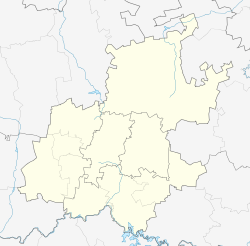Vrededorp, Gauteng
| Vrededorp | |
|---|---|
|
|
|
| Coordinates: 26°11′38″S 28°01′01″E / 26.194°S 28.017°ECoordinates: 26°11′38″S 28°01′01″E / 26.194°S 28.017°E | |
| Country | South Africa |
| Province | Gauteng |
| Municipality | City of Johannesburg |
| Main Place | Johannesburg |
| Elevation | 1,764 m (5,787 ft) |
| Postal code (street) | 2092 |
| PO box | 2141 |
Vrededorp is a suburb of Johannesburg, South Africa. It is located in Region B. Vrededorp is situated on the North-Western side of Johannesburg and is 1,764 m (5,788 ft) above sea level.
Originally populated by Africans, Coloureds, Whites, Chinese, Cape Malays and Indians, it was one of two adjacent suburbs (Pageview and Vrededorp) commonly and onomatopoeically known as "Fietas" after the Men's Outfitters that traded from 14th street in Vrededorp - hence "Fitters" and "Fittas" or, as commonly spelled, "Fietas". The then well-known 14th street was the area's business lane where everybody from across Johannesburg met to snatch up bargains. Most shopkeepers stayed in apartments on top of their shops.
Vrededorp ("Village of Peace"), was named as such in 1895 because of the decision taken to give poor people squatter rights in the area. The idea was that these rights could later be transferred to the heirs of the people that were granted initial squatter rights. After the Anglo Boer War (11 Oct 1899- 31 May 1902), the British did away with the arrangement.
On 19 February 1896 Vrededorp, Braamfontein, Fordsburg and the Malay Location were flattened as a result of a huge explosion caused by a locomotive that reversed into two railway trucks that contained 1955 tons of unstable dynamite. This explosion is commonly known as the "Great Dynamite Explosion".
In 1908 the Indigency Commission started to criticize the living conditions of blacks in and around Johannesburg. This triggered a series of inter-related events. 1909 - the Johannesburg Municipal Commission suggested to make surveyed land available to "natives and other non Europeans". 1910 - Despite strong objections from the black community that they will be excluded from constitutional proceedings, the Union of South-Africa comes into being. Shortly after, in 1911, the first of many labour disputes happened. The next to follow was the founding of the South African Native National Congress (SANNC) in 1912, which later changed its name to African National Congress (ANC). By 1914 the situation deteriorated to such an extent that the Union Government had to place Johannesburg under Martial Law.
...
Wikipedia




